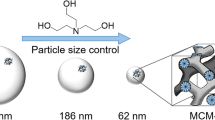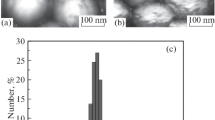Abstract
The interest in core–shell materials with chemically tunable mesoporous surfaces has significantly grown in recent years. The main limitation to obtain these systems through sequential precipitation is the tuning of the core and shell sol-gel chemistry, which usually implies low concentrations and leads to high-quality colloids although in small quantities after a lengthy and costly process. Aerosol approaches can lead to faster production and easier separation of functional materials with well-defined architectures. We present a “green chemistry” general method to coat sub-micron colloidal particles with a variety of mesoporous metal oxide nanofilms via an aerosol synthesis technique. Different types of particulate supports with isotropic and anisotropic shapes were dispersed into the precursor solutions in order to synthesize a mesoporous shell keeping the shape of the support. We chose the synthesis of TiO2 and TiSiO4 nanofilms on conventional Stöber SiO2 spherical particles, and on anisotropic micronized mica particles as a case study. We used the commercial surfactant Pluronic® F127 as a porogen. The structure and composition of the obtained nanofilms were characterized by electron microscopy, X-ray diffraction, focused ion beam coupled to SEM, and nitrogen adsorption/desorption isotherms. The TiO2 shells obtained (with an anatase-like structure) have pore diameters between 3.9–4.8 nm depending on the support with film thicknesses of ~100 nm, while amorphous TiSiO4 shells have larger diameters (9.5–16 nm) with film thicknesses of between 50 and 200 nm depending on the support used. The method presented shows high reproducibility and, unlike batch methods, allows the continuous production and straightforward recovery of the materials.

Highlights
-
An aerosol method for coating sub-micron particles with mesoporous metal oxide films is presented.
-
Stöber SiO2 spherical particles or anisotropic micronized mica particles were used as substrates.
-
The use of aqueous solutions represents an eco-friendly approach to the synthesis of nanomaterials.
-
This method is straightforward and permits the easy production of core-mesoporous shell nanoparticles.








Similar content being viewed by others
References
Shen X, Zheng Q, Kim JK (2021) Prog. Mater. Sci. 115:100708
Kim MS, Kim JW, Yun J et al. (2020) Appl. Surf. Sci. 515:146018
Spoljaric S, Ju Y, Caruso F (2021) Chem. Mater. 33:1099
Deng Y, Qi D, Deng C et al. (2008) J. Am. Chem. Soc. 130:28
Yang Y, Guo X, Wei K et al. (2014) J. Nanoparticle Res. 16:2210
Zhang Y, Dong M, Zhu S et al. (2014) Mater. Res. Bull. 49:448
Ren, Y Ma, Z Bruce PG (2012) Chem. Soc. Rev. 41:4909
Ouyang Y, Li L-X, Xie Z-H et al. (2020) J. Magnes. Alloy. 15
Xiong L, Liu J, Li Y et al. (2019) Prog. Org. Coatings 135:228
Castaldo R, de Luna MS, Siviello C et al. (2020) J. Cult. Herit. 44:317
Zhang Z, Runa A, Wu J et al. (2019) Chinese Chem. Lett. 30:779
Saadaoui M, Fernández I, Sánchez A et al. (2015) Electrochem. Commun. 58:57
Luo W, Xu X, Zhou B et al. (2019) Mater. Sci. Eng. C 100:85
Bruno MM, Franceschini EA, Planes GA et al. (2009) J. Appl. Electrochem. 40:257
Franceschini EA, Gomez MJ, Lacconi GI (2019) J. Energy Chem. 29:79
Jiang J, Kucernak A (2002) J. Electroanal. Chem. 520:64
Gautam J, Thanh TD, Maiti K et al. (2018) Carbon N. Y. 137:358
Lee JE, Lee N, Kim T et al. (2011) Acc. Chem. Res. 44:893
Li Z, Liu M, Fan L et al. (2014) Biosens. Bioelectron. 52:293
Ling Y, Long M, Hu P et al. (2014) J. Hazard. Mater. 264:195
Lv Q, Li G, Sun H et al. (2014) Microporous Mesoporous Mater. 186:7
Sun Y, Sun Y, Wang L et al. (2014) Microporous Mesoporous Mater. 185:245
Mohamed El-Toni A, Khan A, Abbas Ibrahim M et al. (2012) J. Colloid Interface Sci. 378:83
Liu F, Tian H, He J (2014) J. Colloid Interface Sci. 419:68
Lan K, Xia Y, Wang R et al. (2019) Matter 1:527
Faustini M, Boissière C, Nicole L et al. (2014) Chem. Mater. 26:709
Boissiere C, Grosso D, Chaumonnot A et al. (2011) Adv. Mater. 23:599
Franceschini EA, Nanostructured Multifunctional Materials Synthesis, Characterization, Applications and Computational Simulation (CRC Press, First Edition. | Boca Raton: CRC Press, Taylor & Francis, 2021)
Grosso D, Soler-Illia GJ de AA, Crepaldi EL et al. (2003) Adv. Funct. Mater. 13:37
Debecker DP, Le Bras S, Boissière C et al. (2018) Chem. Soc. Rev. 47:4112
Zelcer A, Franceschini EA, Lombardo MV et al. (2020) J. Sol-Gel Sci. Technol. 94:195
Stöber W, Fink A, Bohn E (1968) J. Colloid Interface Sci. 26:62
Thommes M (2010) Chemie-Ingenieur-Technik 82:1059
Rodríguez-Carvajal J (1993) Phys. B Phys. Condens. Matter 192:55
Alexandridis P, Hatton TA (1995) Colloids Surfaces A 96:1
Franceschini EA, Bruno MM, Viva FA et al. (2012) Electrochim. Acta 71:173
Franceschini EA, Planes GA, Williams FJ et al. (2011) J. Power Sources 196:1723
Velasco MI, Franzoni MB, Franceschini EA et al. (2017) J. Phys. Chem. C 121:7533
Rouquerol F, Rouquerol J, Sing K (1999) Vak. Forsch. Und Prax. 11:191
Gregg SJ, Sing K, Adsorption, Surface Area, and Porosity, Second (Academic Press, London, 1982)
Thommes M, Kaneko K, Neimark AV et al. (2015) Pure Appl. Chem. 87:1051
Dhanalekshmi KI, Sangeetha K, Meena KS et al. (2019) Photodiagnosis Photodyn. Ther. 26:79
Bai A, Song H, He G et al. (2016) Ceram. Int. 42:7583
Cai T, Wang Y, Dong Y et al. (2013) Mater. Lett. 111:173
Sakthisabarimoorthi A, Britto Dhas SAM, Jose M (2020) Mater. Chem. Phys. 240:122154
Angelomé PC, Andrini L, Fuertes MC et al. (2010) 13:256
Yin JB, Zhao XP (2002) Chem. Mater. 14:4633
Araujo PZ, Luca V, Bozzano PB et al. (2010) ACS Appl. Mater. Interfaces 2:1663
Violi IL, Perez MD, Fuertes MC et al. (2012) ACS Appl. Mater. Interfaces 4:4320
Angelomé PC, Andrini L, Calvo ME et al. (2007) J. Phys. Chem. C 111:10886
Swanson HE, Fuyat RK, Ugrinic GM (1953) Standard X-Ray Diffraction Powder Patterns
Acknowledgements
The authors thank financial support from Agencia Nacional de Promoción Científica y Tecnológica (PICT 2015-3625, PICT 2015-3853, PICT Start Up 2017–4651, PICT 2017-0250, PUE2017-INFIQC, FSNANO 2010-007, PICT 2018-04236) and CONICET. We gratefully acknowledge M.C. Marchi (CMA, FCEN, UBA) for the SEM images and N. de Vicenzo for the TEM. GG is researcher in the FIB Microscopy Lab (INTI). MVL, AZ, EAF, and GJAAS-I are permanent research fellows of CONICET.
Funding
ANPCYT PICT 2015-3625, ANPCYT PICT 2015-3853, ANPCYT PICT Start Up 2017–4651, ANPCYT PICT 2017-0250, CONICET PUE2017-INFIQC, FSNANO 2010-007.
Author information
Authors and Affiliations
Contributions
Conceptualization: [Esteban Franceschini] [Galo Soler Illia]; Methodology: [Galo Soler Illia], [Andres Zelcer]; Formal analysis and investigation: [Esteban Franceschini] [M. Veronica Lombardo] [Gustavo Gimenez]; Data Analysis: [All authors]; Writing—original draft preparation: [Esteban Franceschini] [M. Veronica Lombardo]; Writing—review and editing: [All Authors]; Funding acquisition: [Galo Soler Illia] [Esteban Franceschini]; Resources: [Galo Soler Illia] [Esteban Franceschini]; Supervision: [Galo Soler Illia].
Corresponding authors
Ethics declarations
Conflict of interest
The authors declare no competing interests.
Additional information
Publisher’s note Springer Nature remains neutral with regard to jurisdictional claims in published maps and institutional affiliations.
Supplementary information
Rights and permissions
About this article
Cite this article
Franceschini, E.A., Giménez, G., Lombardo, M.V. et al. Nanoencapsulation of isotropic and anisotropic particles through a green chemistry aerosol method: a scalable approach for ad-hoc surface tuning. J Sol-Gel Sci Technol 102, 208–218 (2022). https://doi.org/10.1007/s10971-021-05680-1
Received:
Accepted:
Published:
Issue Date:
DOI: https://doi.org/10.1007/s10971-021-05680-1




